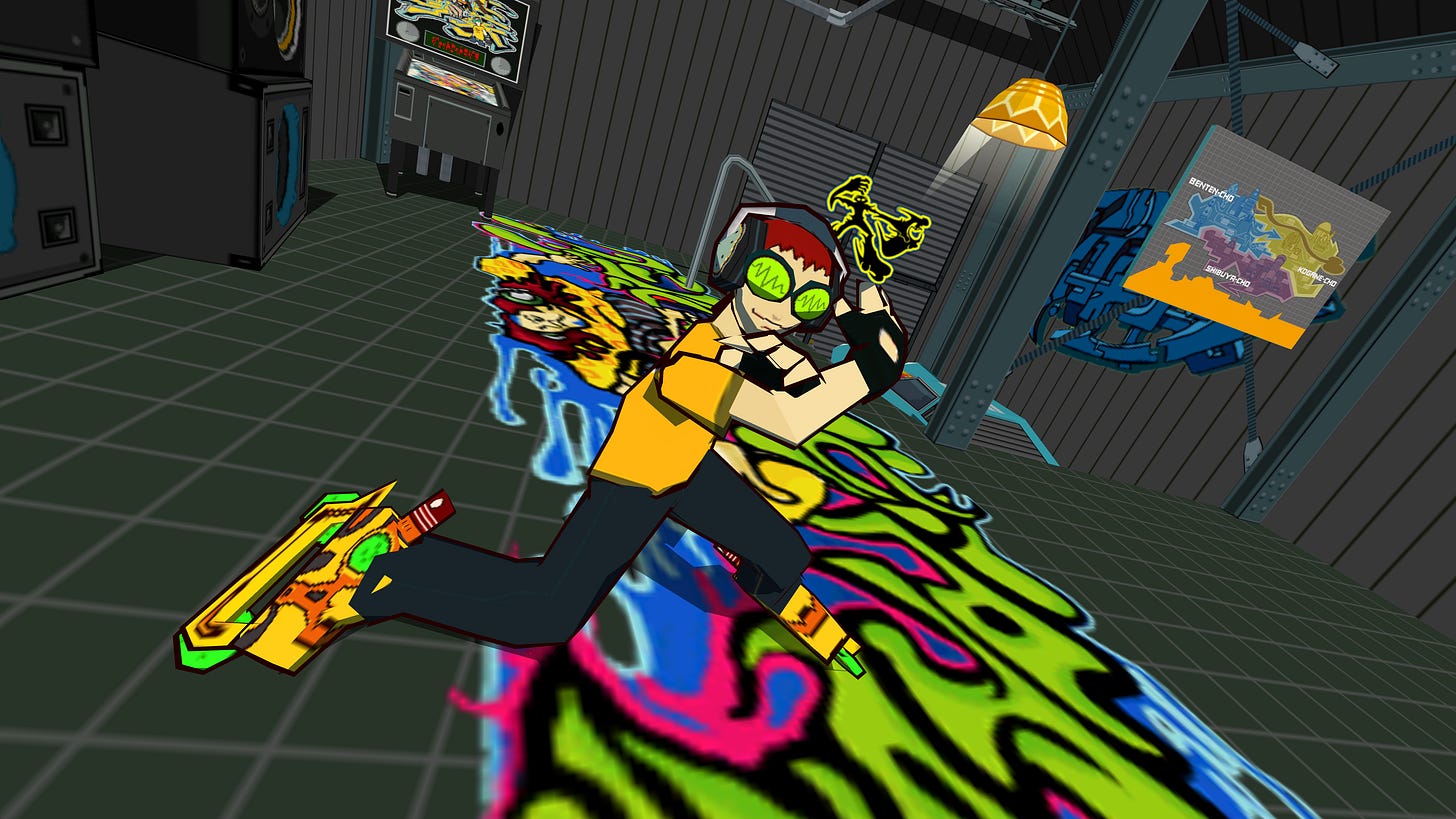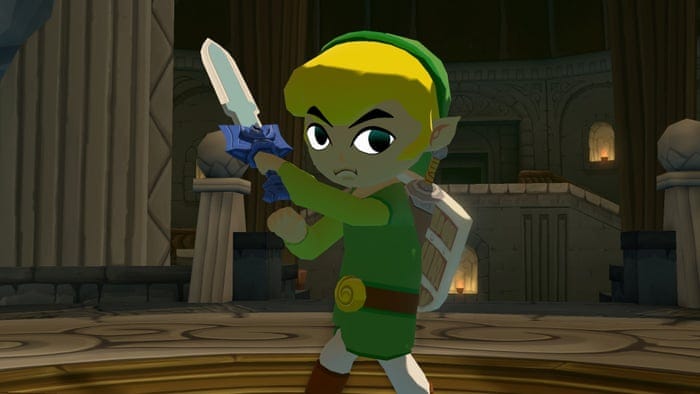No Shade to Cel-Shading
How Jet Set Radio paid homage to one art form and birthed a new one.
We live in a golden era of comic book movies. Faithful representations of story arcs have successfully made their way from the page to the silver screen, with the recent release of James Gunn’s Superman movie garnering an overall positive reaction. But this particular genre has become polarizing in and of itself, as franchises struggle with balancing the fantastical medium of comic books and their larger-than-life characters with real world aesthetics and actors who, unlike the immortal heroes and villains they portray, will very much get older.
Perhaps that’s why despite the continued cycle of comic book movies, there’s really only one that has successfully translated what reading a comic actually feels like—and that would be Spider-Man: Into the Spider-Verse. It did so not just by using onomatopoeias, motion lines, and Ben-Day dots, but also the cel-shaded art style that made computer-generated graphics feel like they were drawn by hand.
And when it comes to the progenitor of that 3-D meets 2-D aesthetic, you can trace that back to Jet Set Radio. Indeed, when the brainchild of Masayoshi Kikuchi and Ryuta Ueda’s Smilebit Studio first made its debut on the Sega Dreamcast on June 29, 2000, it managed to snag a Guinness World Record as the “first videogame to use cel-shading.”
Kikuchi and Ueda sought to create an in-game universe that paid homage to the vibrant Japanese youth culture aesthetic that dominated the late ‘90s. Ura-Harajuku was popping off during the early days of NIGO and Jun Takahashi’s NOWHERE, and the Japanese effect on streetwear and sneakers was starting to take shape, documented by street style magazines like FRUiTs and still-relevant style bibles like Popeye and Brutus.
Moreover, according to a Japanese 4Gamer interview with Kikuchi and Ueda, it was a bit of a punk approach to create a game with a unique, deliberately artistic aesthetic at a time when plenty of publishers were igniting an arms race towards photorealism.
“At that time, games were becoming more and more realistic, but we wanted to take the opposite vector,” says Ueda. Further, going for an illustrated approach to the game made developing it more efficient across design and overall costs. “To create a realistic character, costs are incurred in terms of determining the texture of the skin and clothing, but if you choose to eliminate that, you can create the character as if it were a hand-drawn illustration.”
Indeed, many of the characters represented in the game began as sketches by Ueda, and the cel-shading came about from a desire to represent the drawings as authentically as possible in a 3-D environment. Unlike previous games like Parappa The Rapper which portrayed its flat characters as literally one-dimensional beings in a 3-D environment, cel-shading in Jet Set Radio came about through Ueda and the team of designers experimenting and seeing what was possible.
“When a designer in the department was making an effect, there was a line on the outside, and I asked him how to do it, and he was able to do it well,” explains Ueda. “As for the two-tone shading, I consulted with a programmer who was in the PC Research Lab at the time, and we were able to achieve it. Thinking about it again, I think Sega's technical capabilities were amazing.”
In Ueda’s drawings, he got the idea to put his characters in inline skates as he thought they would look cooler than regular shoes, but also adding a different dynamic to game traversal. Whereas a skateboard would be a totally separate accessory, inline skates could be more easily incorporated into a character’s outfit.
“At the time, ‘X Games’ was popular, so if you run through a 3-D stage on inline skates, it would be interesting to incorporate tricks and grinds into the action, and I expanded the game design,” says Kikuchi.
The game’s defining element of adding graffiti came later on, and famously contains contributions from legendary writer Eric Haze, as well as some original tags from Ueda. But it’s ironic that a game meant to emulate the energy of street culture at the time—as well as pay homage to graffiti—not only went on to inspire later releases like Marc Ecko’s Getting Up: Contents Under Pressure and even Virgil Abloh and KATSU’s OFFKAT game celebrating their OFF-WHITE capsule collection, but it ended up inspiring a whole new generation of cel-shaded games.
Among the most famous is Nintendo’s Legend of Zelda: The Wind Waker, which used the cel-shading technique to add a more cartoonish quality to the franchise hero Link. But many of the other games done in this art style did a better job of championing Jet Set Radio’s other legacy: creating novel games that embraced their own weirdness and weren’t afraid of pushing the envelope.
Hideki Kamiya’s Viewtiful joe took the side-scrolling beat-em-’up and gave it all the flash of a frenetic anime fight scene. Goichi Suda’s Killer7 is arguably one of the most bizarre games ever created, part-FPS, part-psychological thriller, and part something that would probably come from the mind of a director like Takashi Miike.
Even now, cel-shading has become a staple of other successful franchises like the Borderlands series and of course, remains a part of the Zelda canon with Breath of the Wild and its sequel Tears of the Kingdom fully embracing the style. More recently, JSR spiritual successor Bomb Rush Cyberfunk makes no secret out of what inspired the game, going as far as enlisting Hideki Naganuma (who put together JSR’s memorable soundtrack) for the music. It seems 25 years after its initial release, Jet Set Radio’s influence remains as traceable as ever.




![Thumbnail image of Image Gallery No. 048 / [Interview] Celebrating "Showa's 99th Anniversary"! "Jet Set Radio" developers talk about the story behind the birth of the series and their enthusiasm for the completely new game Thumbnail image of Image Gallery No. 048 / [Interview] Celebrating "Showa's 99th Anniversary"! "Jet Set Radio" developers talk about the story behind the birth of the series and their enthusiasm for the completely new game](https://substackcdn.com/image/fetch/$s_!VoWq!,w_1456,c_limit,f_auto,q_auto:good,fl_progressive:steep/https%3A%2F%2Fsubstack-post-media.s3.amazonaws.com%2Fpublic%2Fimages%2Fe7b7bf18-fc64-4958-8290-e0d98dc8e4c3_512x512.jpeg)
![Thumbnail image of Image Gallery No.012 / [Interview] Celebrating "Showa's 99th Anniversary"! "Jet Set Radio" developers talk about the story behind the birth of the series and their enthusiasm for the completely new game Thumbnail image of Image Gallery No.012 / [Interview] Celebrating "Showa's 99th Anniversary"! "Jet Set Radio" developers talk about the story behind the birth of the series and their enthusiasm for the completely new game](https://substackcdn.com/image/fetch/$s_!YNvQ!,w_1456,c_limit,f_auto,q_auto:good,fl_progressive:steep/https%3A%2F%2Fsubstack-post-media.s3.amazonaws.com%2Fpublic%2Fimages%2F6b3543ab-106c-42d2-926c-69b668cf5d80_512x677.jpeg)

Great article!
Excellent Story and was surprising to see it this morning. In the rollerblading side of the internet this has been a big event recently, Them Skate https://www.themgoods.com/ has a collab skate with SEGA for this release.